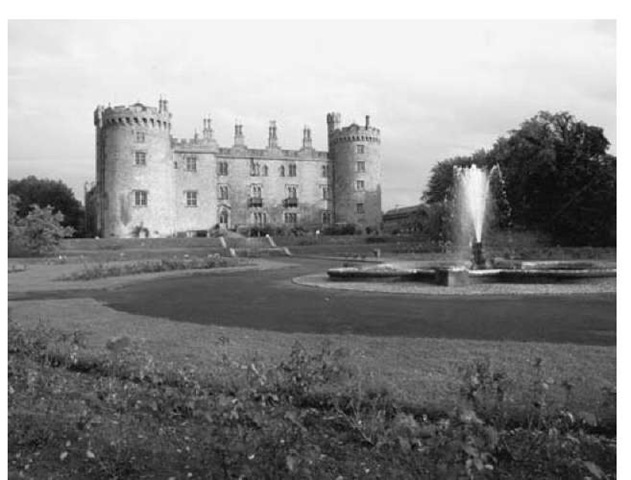Kilkenny is the name of a cathedral town, county (from c. 1207), lordship, and liberty (1247-c. 1402) in southeast Ireland. The town, which straddles the River Nore, derives its name from the Irish Cell Chainnigh (church of [St.] Canice). An earlier Christian settlement, the martartech Mag Roigne (relic house of Rogen’s plain), was established in the fifth century, and although it continued through the Middle Ages as a church dedicated to St. Patrick, it was eclipsed in importance during the seventh and eighth centuries by the newer church of Canice. In 1111, at the synod of Raith Bressail, St. Canice’s became a cathedral. By the middle of the twelfth century, Kilkenny was one of the principal residences of the Mac Gilla Patraic kings of Osraige and, when the Anglo-Normans arrived in 1169, it was the largest and most important inland settlement in the southeast.
Kilkenny Castle from the Rose Garden.
Although an Anglo-Norman castle existed by 1173, when it was burnt by Domnall Mor Ua Briain, king of Thomond, it was not until the 1190s that an enduring Anglo-Norman settlement was established. William Marshal was a key figure in this regard. He came to Kilkenny in 1207 and granted its first charter. He obtained land from the bishop to enlarge the town, and he founded the Augustinian priory of St. John, which dominated the eastern bank of the town until the Dissolution. Marshal’s most enduring contribution, however, was the construction of a stone castle of quadrangular plan with massive, circular, corner towers. It functioned as the administrative center of the lordship of Kilkenny, passing in succession from the Marshals to the de Clares in 1248 and to the Dispensers in 1317, before being sold in 1391 to James Butler, third earl of Ormond, whose descendants lived there until 1936.
Kilkenny was a twin town throughout the Middle Ages. The pre-Norman settlement, known as Irish-town, remained a separate borough with the bishop of Ossory as its lord. It was dominated by St. Canice’s Cathedral, a Gothic structure initiated by the diocese’s first Anglo-Norman bishop, Hugh de Rous (1202-1218). The Anglo-Norman town, known as Hightown or Englishtown, was laid out along a single main street linking the castle with the cathedral and was given its own parish church dedicated to St. Mary. About 1225 a Dominican priory was founded, and a Franciscan house was added between 1231 and 1234. In 1231 an urban administration was established with a sovereign (Latin superior) as its head. Over the succeeding centuries this body obtained market rights and jurisdictional privileges for the town that enabled it to surpass Irishtown in wealth and influence. The hinterland is excellent corn-growing country, and there were at least six mills in Kilkenny from the early thirteenth century. It was also an important center of cloth production, brewing, and iron-working. At its maximum in the late thirteenth century it is estimated that the combined towns had a population of about 4500. After 1300, the numbers declined. Kilkenny was devastated by the Black Death in 1348 and 1349, the effects of which were vividly described by the local Franciscan chronicler, John Clyn. Suburbs were abandoned, extramural chapels were demolished, and some bur-gages remained waste into the first quarter of the fifteenth century.
Kilkenny was a major venue for meetings of the king’s council and parliament, one or the other of which convened there on at least thirty-four occasions between 1277 and 1425. The most famous (or infamous) gathering was the parliament of 1366 presided over by Lionel, duke of Clarence, which promulgated the statute of Kilkenny. The urban culture of the thirteenth and fourteenth centuries was vehemently hostile to the native Irish, viewing them as "natural enemies." This attitude evidently relaxed during the fifteenth century, when the Liber primus Kilkenniensis, the oldest town book, records burgesses and craftsmen with Gaelic surnames. A key factor in the process of Gaeli-cization was the purchase of Kilkenny by the earl of Ormond in 1391. This broke the link with English-based lords and introduced a family that had built up its power base by the skilful management of the Irish in the march of Tipperary. The fifteenth century was a period of urban consolidation characterized by subtle social and economic changes, reflected topographically by redevelopment and reconstruction. After 1425 there is evidence of a demand for building space within the walls and, after 1460, both major bridges and almost all the town gates, mural towers, churches, and religious houses were rebuilt. These developments coincide with the emergence of an oligarchy of about fifteen families that dominated the town into the early modern period.

